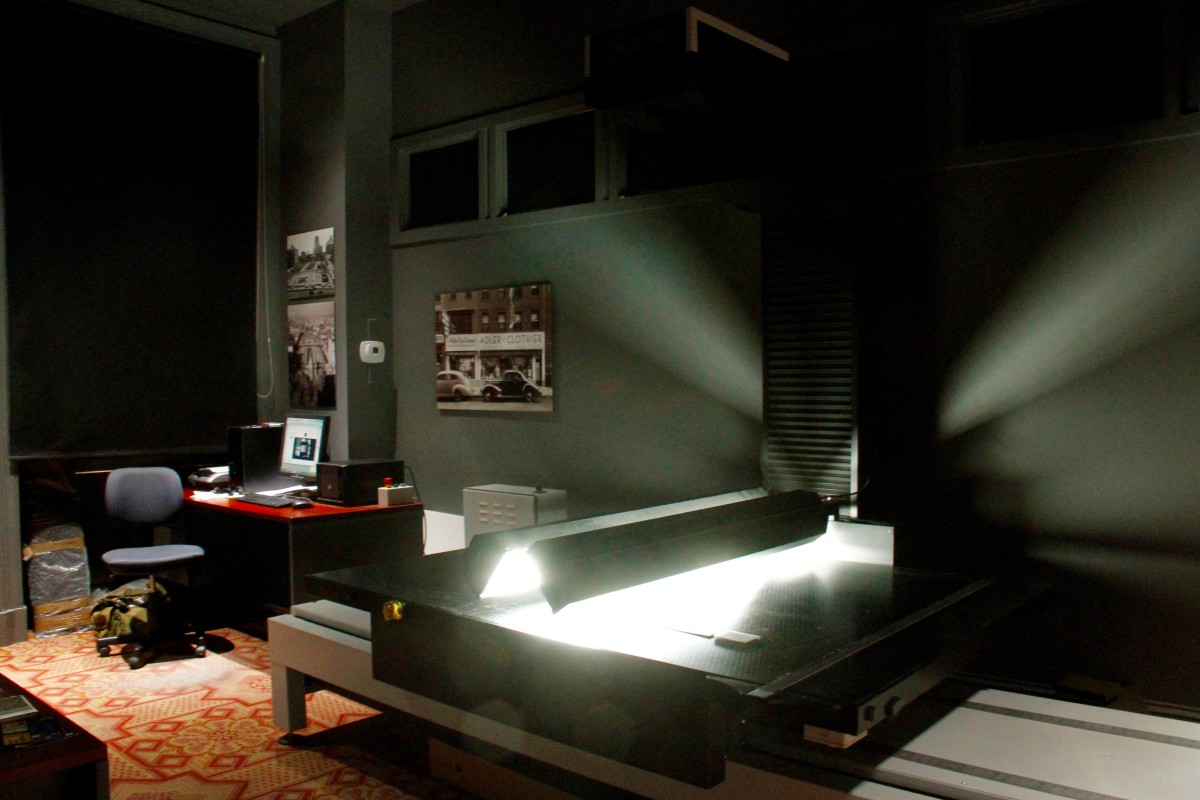Some very impressive documents have lain on the bed of the Cruse SC 220 ST Fine Art Scanner that dominates a back room of the Athenaeum of Philadelphia.
They include:
- Four or five copies of the Declaration of Independence.
- The Treaty of Paris.
- The text of the Emancipation Proclamation signed by President Abraham Lincoln, and the witness book from his assassination.
There was even New Jersey’s copy of the Bill of Rights, which got a state police escort to foot of the Ben Franklin Bridge, and a manuscript of Chaucer’s Canterbury Tales, handwritten and illustrated circa 1450.
“I asked what the value was,” imaging specialist Jim Carroll recalled of the conversation afterwards, and the answer left him relieved he hadn’t known before he handled the volume.
Originally the Athenaeum, a private membership library right off Washington Square Park, just wanted to figure out a way to scan its own collection of architectural drawings — including many on tissue paper too fragile to leave the building. These included over 18,000 by the designer of the Ben Franklin Bridge, Paul Philippe Cret, including a true-to-scale drawing of a 12-foot lamppost.

Athenaeum staffers learned about the scanners produced by the German firm, Cruse. At four-by-six feet, and extremely high-res, the model is unusually large and specialized. The Athenaeum began raising the funds to purchase one.
Around that time Bruce Laverty, the library’s curator of architecture travelled to Austria for a conference of architectural museums. He went on an after-hours tour of Vienna’s architecture museum. He saw their Cruse scanner, used during the day by museum staff and overnight by a private reproductions company.
“That’s when the lightbulb went off in my head,” he said, that the scanner could eventually pay to sustain the library’s digitization program in the long term by performing work for other clients.
The Athenaeum acquired its own scanner for $135,000 in 2004 with the help of a grant from the Francis Gould Foundation. The Cruse scanner is unusually large and specialized and more widely sold in Europe. Michael Seneca, the director of the Athenaeum Imaging Center, says there were only two in the U.S. when the library purchased its own.
The new Regional Digital Imaging Center got to work completing the Philadelphia Architects and Buildings project, an online archive.
Explore the archive
It also began taking on work from individuals, museums and even private companies.
Today the scanner runs about 50 hours a week on projects for the Athenaeum and its clients and has completed over 200,000 scans. Images too large for their equipment get stitched together digitally from multiple passes. From their conversations with the Cruse company, the staff of the Athenaeum thinks it has done more large-format scans than most of the others out there.
Normally, the scanner makes a low humming noise, but a vacuum that can hold paper down flat when needed escalates the volume to an industrial-level roar.
The library also acquired a 44 inch archival-quality printer about five years ago, which is installed across the hall. Since then, they have begun doing a large amount of reproduction work. On a recent morning, Carroll had the work in a local, young artist’s first show laid out.
Another customer is commercial artist Perry Milou, who recently became licensed as the exclusive artist for Pope Francis’ 2015 visit to Philadelphia. He started coming to the Athenaeum to scan his work about the time they acquired the printer.

“There is no competition in terms of using camera or any other scanner in the area,” Milou explained, and he likes that he now has his work printed there too. He appreciates the efficiency.
“I just got call from gallery in Israel an hour ago that wants to buy prints from me. I’ll end up shipping prints from the Athenaeum to Israel next week.”
Other notable clients of the Athenaeum’s Regional Digital Imaging Center have included the Library of Congress and the White House, which wanted to restore the old Executive Office Building to its original state after the Navy and State Department moved out. Unfortunately, State had taken the portraits in the building and refused to give them up.
The White House couldn’t even obtain them to scan and finally sent the Athenaeum high-res photographs. The super-detailed reproductions now hang in Washington, indistinguishable to most visitors from the originals. The imaging center produced another portrait a few months later for the West Wing.
The City of Philadelphia’s water and streets departments commissioned scans of maps they also contributed to the library’s GeoHistory online archiving project. In fact, Michael Seneca, director of the Athenaeum’s imaging center said, “We’ve done work for just about every institution in the city.”
“Part of the selling point besides the scanner is we work in a museum so we know how to handle these documents,” he said. That said, some institutions will still insist on having their own staff place each page on the scanner themselves.







